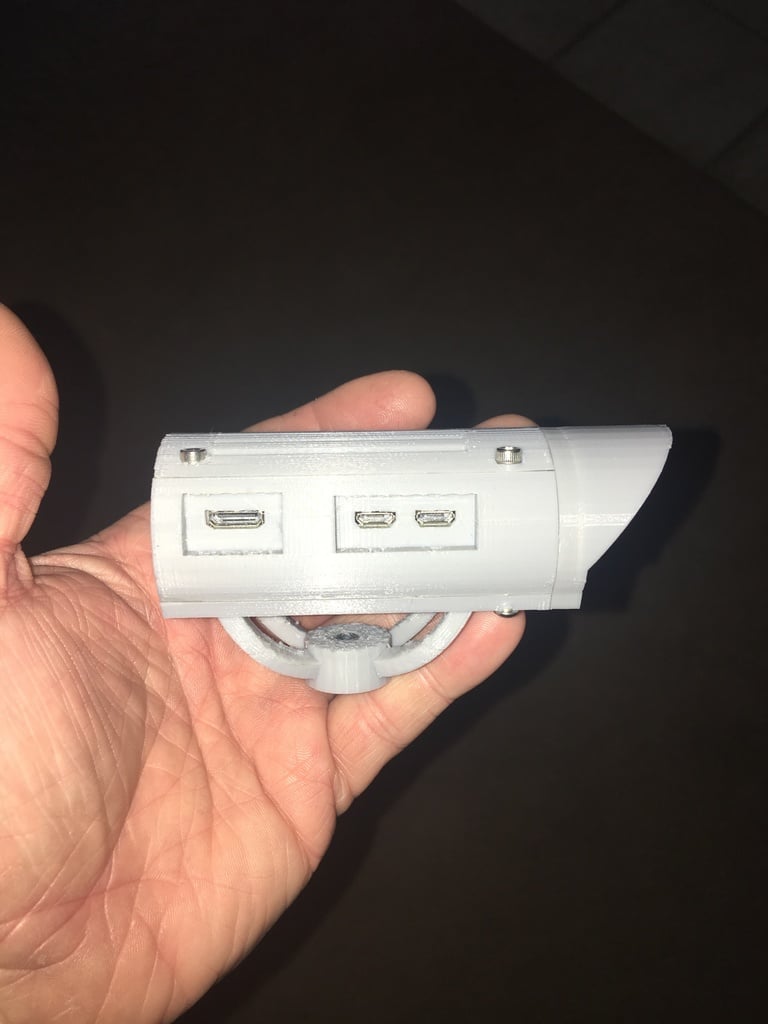
Raspberry Pi Zero W Security Camera
thingiverse
It seems like you've provided a step-by-step guide on how to set up a Raspberry Pi Zero as a surveillance camera using MJPG-Streamer, RPi.GPIO for LED control, and possibly integrating it with some security software. I'll break down the steps into manageable sections and provide additional context where necessary. ### Step 1: Setting Up MJPG-Streamer First, you need to install MJPG-streamer on your Raspberry Pi Zero. The instructions provided seem to be a mix of installing and setting up MJPG-streamer with Python scripts for LED control. Here's how you can achieve this: 1. Install MJPG-Streamer: ```bash sudo apt-get update sudo apt-get install mjpg-streamer -y ``` 2. Create a configuration file for MJPG-Streamer at `/etc/mjpg-streamer.conf`. However, the provided instructions skip the detailed steps on configuring this file. 3. The script `python /home/pi/red_led_blink.py &` and `python /home/pi/green_led_on.py &` are added to `/etc/rc.local`. These scripts use RPi.GPIO library for LED control. ### Step 2: Setting Up Python Scripts 1. The provided instructions mention creating a file called `red_led_blink.py` and `green_led_on.py`, but they don't explain how these files are created or what they do in detail. To create these scripts, you would use an editor like `nano`: ```bash sudo nano /home/pi/red_led_blink.py ``` And paste the content provided in the instructions into this file. Repeat the process for the green LED script. 2. The contents of these files control the red and green LEDs on your Raspberry Pi Zero using RPi.GPIO library. However, there seems to be a typo in the green LED script (`des$\r\n`). Here's the corrected version of `green_led_on.py`: ```python import RPi.GPIO as GPIO import time LedPin = 11 # pin11 def setup(): GPIO.setmode(GPIO.BOARD) # Numbers GPIOs by physical location GPIO.setup(LedPin, GPIO.OUT) # Set LedPin's mode is output GPIO.output(LedPin, GPIO.HIGH) # Set LedPin high(+3.3V) to turn on led def on(): while True: GPIO.output(LedPin, GPIO.HIGH) # led on time.sleep(1) GPIO.output(LedPin, GPIO.LOW) # led off time.sleep(3) def destroy(): GPIO.output(LedPin, GPIO.LOW) # led off GPIO.cleanup() # Release resource if __name__ == '__main__': # Program start from here setup() try: on() except KeyboardInterrupt: # When 'Ctrl+C' is pressed, the child program destroy() will be executed. destroy() ``` 3. Make these scripts executable with `chmod` command as shown in the instructions. ### Step 3: Configuring MJPG-Streamer Since there are no specific steps provided for configuring `/etc/mjpg-streamer.conf`, here's a basic example: ```bash # /etc/mjpg-streamer.conf [input] # path to input plugin plugin = input_uvc.so # video input dev=/dev/video0 # YUYV is the most efficient format, but may require ffmpeg conversion for playback on some devices. yuyv=true [stream] # set this to the path of your MJPG streamer executable (default: /usr/bin/mjpg_streamer) plugin = output_http.so port=8080 ``` This configuration tells MJPG-Streamer to use the first camera (`/dev/video0`) and serve the video stream on port 8080. ### Step 4: Rebooting and Verifying 1. Add `python /home/pi/red_led_blink.py &` and `python /home/pi/green_led_on.py &` before `exit 0` in `/etc/rc.local`. 2. Reboot your Raspberry Pi Zero with `sudo reboot`. 3. Once it comes up, your green light should be on and the red light will flash at intervals. 4. You can access your MJPG-streamer by visiting `http://your_pi_ip:8080` in your web browser. Remember to replace `your_pi_ip` with the actual IP address of your Raspberry Pi Zero. ### Additional Tips - The instructions seem incomplete, and it's unclear what software you're trying to integrate this setup with. If you're trying to use Ispy Surveillance or Active Webcam, please note that these may require additional configuration steps. - Make sure to check the Python scripts for any typos or syntax errors before executing them. - You can adjust the interval of the red LED flashing by modifying the `time.sleep()` function in the `red_led_blink.py` script.
With this file you will be able to print Raspberry Pi Zero W Security Camera with your 3D printer. Click on the button and save the file on your computer to work, edit or customize your design. You can also find more 3D designs for printers on Raspberry Pi Zero W Security Camera.
